Do Britain's Lamp-posts Drive You Mad?
By Alexander Barrie
An article from ‘Everybody’s
Weekly’ magazine 16th November 1957.
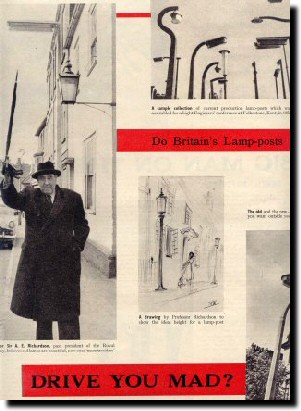
To most people, the only thing that matters about a lamp-post is the light it gives. But some people bewilder officials with the violence of their dislikes for new lighting schemes. As a rule it is not the extra light that upsets them – although this can cause trouble, too – but the appearance of the new lamp-posts.
Modern lamp-posts have grown tall. On all main routes they must, by Ministry of transport regulations, be twenty-five feet high. Posts like these, in the eyes of critics, ruin the scene.
But Britain’s streets are said to be the best lit in the world. That, in the opinion of lighting engineers, is what counts.
Thoughts about beauty have not been allowed to obstruct the struggle to make Britain’s streets the safest anywhere to walk, cycle, or drive along. The critics don’t agree with this outlook at all. They argue that they’ll happily put up with poor light if they can keep the scenery unchanged.
One of the angriest arguers is seventy-seven year old Professor Sir A E Richardson, past president of the Royal Academy and member of the Fine Arts Commission. The professor most hates concrete posts.
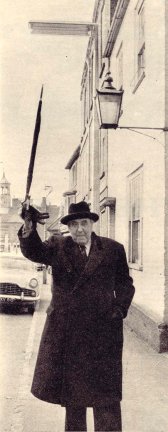
Now the Professor’s own local authority has defied his wrath by putting up one of the hated concrete posts right outside his eighteenth - century house in Ampthill, Bedfordshire.
Although Professor Richardson has been the most outspoken of the concrete post haters, he has been by no means alone. For example, when Marylebone Borough Council decided recently to erect new, twenty-five foot posts in St John’s Wood, London, local residents began to protest.
Soon they banded together as members of the St John’s Wood Preservation Society, which began by organising an anti concrete-post petition in the area. Three thousand people signed it. The completed petition was then given to the embarrassed council, which was uncertain about what it should do about the problem.
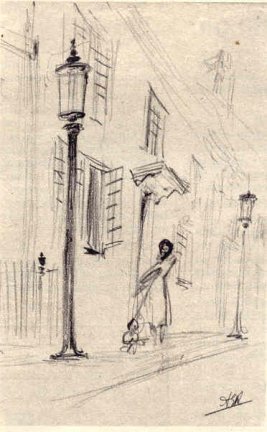
One of the difficulties that has always fogged discussion about the appearance of new street lights is the lack of agreement between the experts on what it is that makes a lamp-post ugly. Members of the Fine Arts Commission, for instance, approved a number of designs for modern lamp-posts only to see some of them abruptly rejected by the government-backed Council of Industrial Design a little later. The public, and in particular the manufacturers, have found all this apparent lack of decision very bewildering.
Meanwhile, better street lighting is going ahead – because it must. It is known that good street lighting helps keep night-time accidents on our grossly over-crowded roads to a minimum. The lighting experts are concentrating on the heavy technical and financial problems of their work and leaving it to the more sensitive citizens to argue out the aesthetics.
There are three types of lamp in general use for street lighting today. Technicians from one of the leading street lighting contractors, the General Electric Company, believe these have been so well developed that nothing is on the way to displace them.
The strong yellow sodium is one. Opinion about its colour effect differs. In the north of the Country it seems especially popular. Lighting experts have found that people there like the rich gold colour of its light. Besides, sodium is cheaper to install than the other two alternatives - the bluish green mercury and near white fluorescent lamps. Of course, it’s still very costly. To light one mile of road with sodium’s will cost little less than £2,900. But other methods send that figure leaping to £3,700. This is one compelling reason why most out of town highways are now being lit with sodium’s; over long distances a saving of £800 a mile adds up to a lot of money.
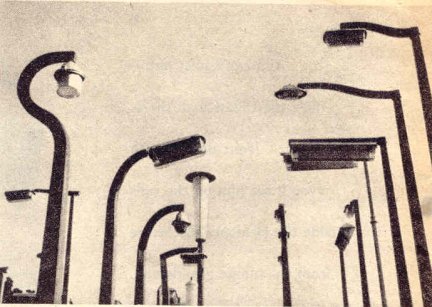 In the early days of street lighting arguments about costs –
which have always been high – were common. Little is known about the worries of
Britain’s first street lighters, the Roman’s, who strung oil-burning lamps
above our streets 1,600 years ago. But it is known that a long argument about
street lighting began between Londoners and their Lord Mayor as early as 1417.
He ordered them to hang out lanterns on winter evenings at their own cost. They
did so, but unable to see why they should pay the bill, refused to light them.
In the early days of street lighting arguments about costs –
which have always been high – were common. Little is known about the worries of
Britain’s first street lighters, the Roman’s, who strung oil-burning lamps
above our streets 1,600 years ago. But it is known that a long argument about
street lighting began between Londoners and their Lord Mayor as early as 1417.
He ordered them to hang out lanterns on winter evenings at their own cost. They
did so, but unable to see why they should pay the bill, refused to light them.
It took about a hundred years of scolding, threats of punishment and new regulations to make the householders change their minds. Even then the candles blew out as often as not to leave the city its usual economical darkness.
For another 300-years or so, such small-scale street lighting as there was had to be paid for by volunteers. For ten years in the 1690’s and early 1700’s a man named Hemig gave London a limited lighting scheme on some sort of commercially organised basis. But for the most part street lights were one spot affairs donated during or after the life of people wishing to glorify their names.
Yet by 1807 the beginnings of real street lighting could be seen. Gas lights were tested by a brewery in London. Their dazzling brilliance amazed the simple people who saw them. Then, when a few of the lamps had been put up, another argument began. Doctors warned of the risk to health from ‘gas emanations’; moralists moaned of the evils, which must follow this new temptation to stay out late; the over-devout cursed the invention as blasphemous for spoiling God’s plan to divide night from day. But by the 1850, street lighting as well established. The post offered new opportunities to the designers of the day. Some old posts have survived from George IV’s reign.
Just twenty-eight years later, electricity came to strengthen street lighting. Area by area gas lamp-posts were replaced or converted for better brilliance. The process is still going on. London’s famous Victoria Street is gas lit, but it won’t be for long. The authorities are nearly ready to start the conversion. Florescent lanterns have been chosen by the wary officials who hope for no new uproar from the preservation societies. They point out that this is just another step in a programme, which has been running since 1878, when sixteen electric arc lamps replaced eighty-six gas lamps along Holborn Viaduct, London.
The huge affection some people have for gas lamps was shown by sculptor, Arnold Machin, R.A., in a recent contest with authorities. He fought to preserve a 100-year old lamp-post outside his Stoke-on-Trent house. When workmen came at last to take it away, he flung his arms around it and asked for his wife to padlock his wrists together. For six hours he clung there devotedly, defying anyone to remove him or the post. But he lost his lamp-post in the end.
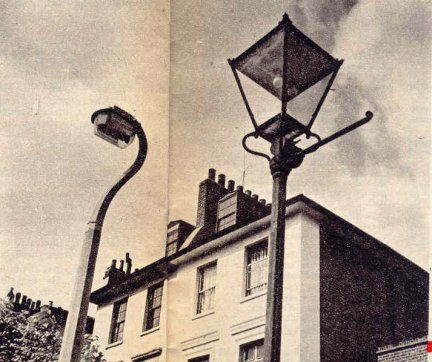
Another current struggle, deadlocked for the moment, is highlighted at Richmond, Surrey. The Fine Arts Commission has given support to a group of citizens ho have sworn to prevent an assault on the little, iron gas lamps, which have lit the Green there for over a century. Once more it is the concrete posts, which are the enemy. If the authorities have their way, new posts will replace the old.
Nobody in the street lighting business forecasts any quick end to the fights about lighting.
But, meanwhile, technical progress is steady. The aim is for the brightest, most even brilliance possible on the road surface, so that people and things can be seen in silhouette against it. Altogether, street lighting works are costing over £12 million a year just for England and Wales. Experiments, using delicate instruments and skilled observers, never stop.
Over 150 years ago, a French civil engineer, Count Joseph Gascon Jean Baptist Thiville, defined lighting perfection as “…if the whole pavement and street could be illuminated without our perceiving from where the light proceeds.” Most modern experts still agree with that. But they also know that this perfect state of affairs is going to be a very long time coming. Meanwhile, they fight back against the critics for more and better public lighting. If Britain’s streets are already the best lit in the world, can you doubt who’s winning?
Return to Articles and Features section
Copyright(c) 2006 Claire Pendrous. All rights reserved.
Please note that all pictures are by Claire Pendrous, or are part of the Claire Pendrous photographic collection unless otherwise stated; none of these images can be copied without obtaining prior permission.